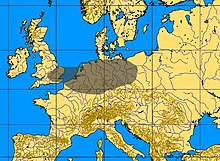 | |
| Geographical range | Europe |
|---|---|
| Period | Mesolithic Europe |
| Dates | c. 12,900–11,700 BP |
| Type site | Ahrensburg |
| Preceded by | Magdalenian |
| Followed by | Maglemosian culture; Swiderian culture |
The Ahrensburg culture or Ahrensburgian (c. 12,900 to 11,700 BP[1]) was a late Upper Paleolithic nomadic hunter culture (or technocomplex) in north-central Europe during the Younger Dryas, the last spell of cold at the end of the Weichsel glaciation resulting in deforestation and the formation of a tundra with bushy arctic white birch and rowan. The most important prey was the wild reindeer. The earliest definite finds of arrow and bow date to this culture, though these weapons might have been invented earlier. The Ahrensburgian was preceded by the Hamburg and Federmesser cultures and superseded by the Maglemosian and Swiderian cultures. Ahrensburgian finds were made in southern and western Scandinavia, the North German plain and western Poland. The Ahrensburgian area also included vast stretches of land now at the bottom of the North and Baltic Sea, since during the Younger Dryas the coastline took a much more northern course than today.
The culture is named after a tunnel valley near the village of Ahrensburg, 25 km (16 mi) northeast of Hamburg in the German state of Schleswig-Holstein, where Ahrensburg find layers were excavated in Meiendorf, Stellmoor and Borneck. While these as well as the majority of other find sites date to the Young Dryas, the Ahrensburgian find layer in Alt Duvenstedt has been dated to the very late Allerød, thus possibly representing an early stage of Ahrensburgian which might have corresponded to the Bromme culture in the north. Artefacts with tanged points are found associated with both the Bromme and the Ahrensburg cultures.
- ^ Ashton, Nick (2017). Early Humans. London: William Collins. p. 313. ISBN 978-0-00-815035-8.